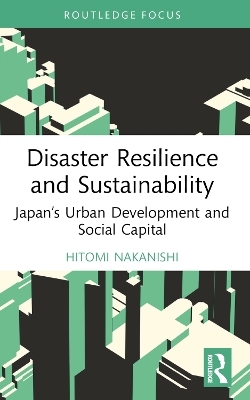
Disaster Resilience and Sustainability
Japan’s Urban Development and Social Capital
Seiten
2024
Routledge (Verlag)
978-0-367-71292-1 (ISBN)
Routledge (Verlag)
978-0-367-71292-1 (ISBN)
This book examines urban planning and infrastructure development in Japanese cities after the second world war as a way to mitigate the risks of disasters while pursuing sustainable development. It will be of interest to scholars in city development and planning, urban studies and human geography.
This book examines urban planning and infrastructure development in Japanese cities after the second world war as a way to mitigate the risks of disasters while pursuing sustainable development. It looks at the benefits of social capital and how communities organise to tackle problems during the recovery phase after a disaster. The book also illustrates with case studies to highlight community attitudes which improve recovery outcomes.
The book underlines challenges such as ageing and depopulation which Japan would face should the next disaster occur. These demographic shifts are causing difficulties among neighbourhood associations at a time when communities need to effectively support each other. Nakanishi explains why overcoming these societal issues is imperative for sustainability and the need for a comprehensive approach which would integrate smart technology.
This book will be of interest to scholars in city development and planning, urban studies and human geography, as well as those interested in building resilient communities.
This book examines urban planning and infrastructure development in Japanese cities after the second world war as a way to mitigate the risks of disasters while pursuing sustainable development. It looks at the benefits of social capital and how communities organise to tackle problems during the recovery phase after a disaster. The book also illustrates with case studies to highlight community attitudes which improve recovery outcomes.
The book underlines challenges such as ageing and depopulation which Japan would face should the next disaster occur. These demographic shifts are causing difficulties among neighbourhood associations at a time when communities need to effectively support each other. Nakanishi explains why overcoming these societal issues is imperative for sustainability and the need for a comprehensive approach which would integrate smart technology.
This book will be of interest to scholars in city development and planning, urban studies and human geography, as well as those interested in building resilient communities.
Hitomi Nakanishi is Associate Professor of Built Environment at the University of Canberra, Australia.
1. Introduction 2. Japan’s Urban Planning and Infrastructure Development after WWII 3. Social Capital: Community Responses to Natural Hazards 4. Typhoon Nation: Lessons of 2004 5. Community as a Hub of Response: Kumamoto Earthquake of 2016 6. Floods and Evacuation Challenge: Western Japan Flood of 2018 7. Beyond Sustainability 8. Conclusion
| Erscheinungsdatum | 05.07.2022 |
|---|---|
| Reihe/Serie | Routledge Research in Sustainable Planning and Development in Asia |
| Zusatzinfo | 7 Tables, black and white; 4 Line drawings, black and white; 16 Halftones, black and white; 20 Illustrations, black and white |
| Verlagsort | London |
| Sprache | englisch |
| Maße | 138 x 216 mm |
| Gewicht | 453 g |
| Themenwelt | Naturwissenschaften ► Geowissenschaften ► Geografie / Kartografie |
| Sozialwissenschaften ► Soziologie ► Spezielle Soziologien | |
| Technik ► Architektur | |
| Wirtschaft ► Volkswirtschaftslehre | |
| ISBN-10 | 0-367-71292-X / 036771292X |
| ISBN-13 | 978-0-367-71292-1 / 9780367712921 |
| Zustand | Neuware |
| Informationen gemäß Produktsicherheitsverordnung (GPSR) | |
| Haben Sie eine Frage zum Produkt? |
Mehr entdecken
aus dem Bereich
aus dem Bereich
Eine Einführung in die spezielle Mineralogie, Petrologie und …
Buch | Hardcover (2022)
Springer Spektrum (Verlag)
CHF 83,95
über eine faszinierende Welt zwischen Wasser und Land und warum sie …
Buch | Hardcover (2023)
dtv (Verlag)
CHF 33,55


